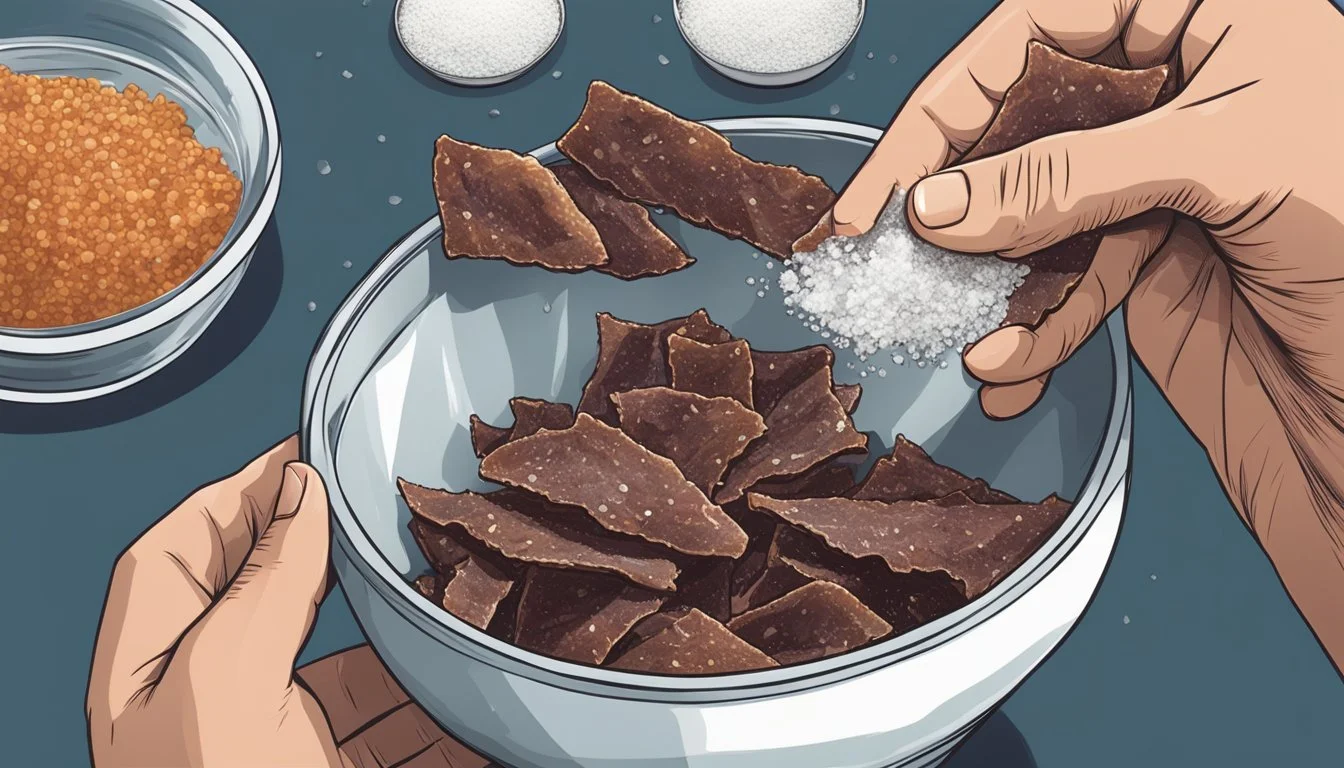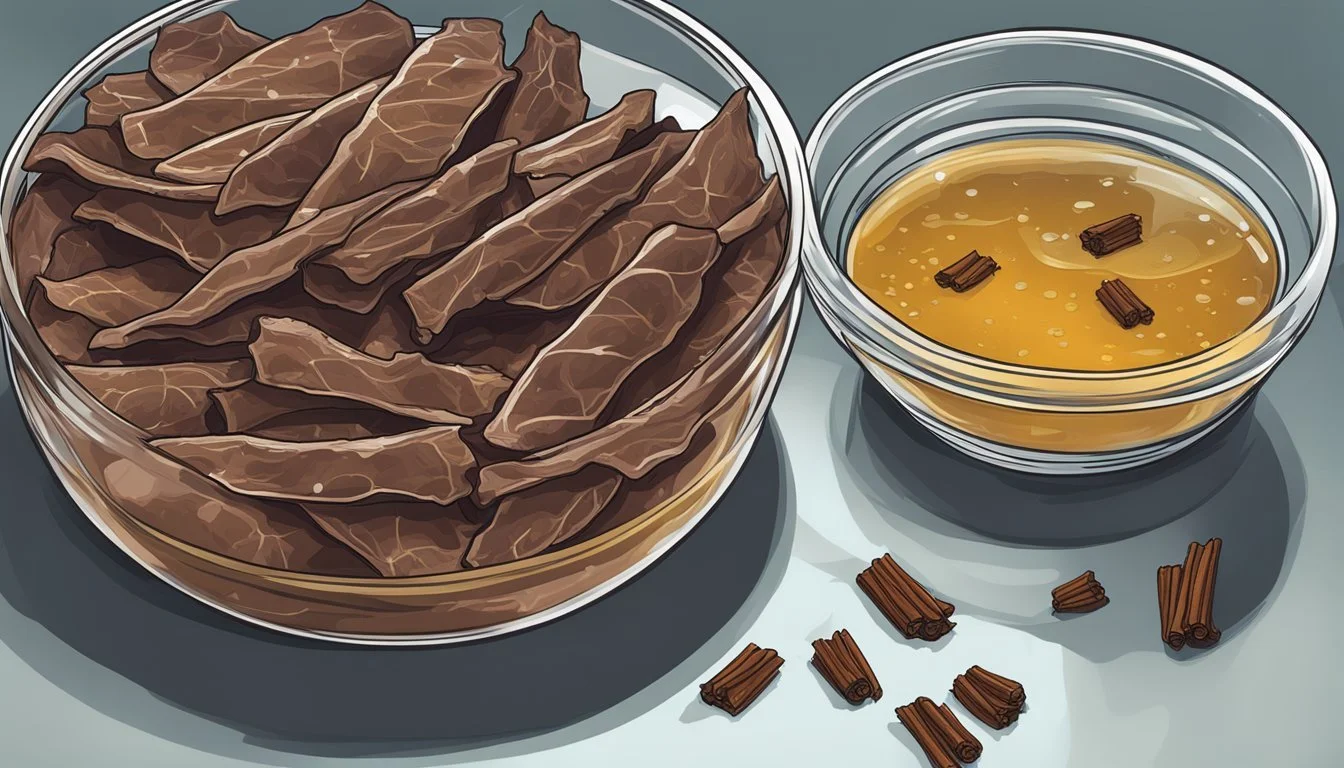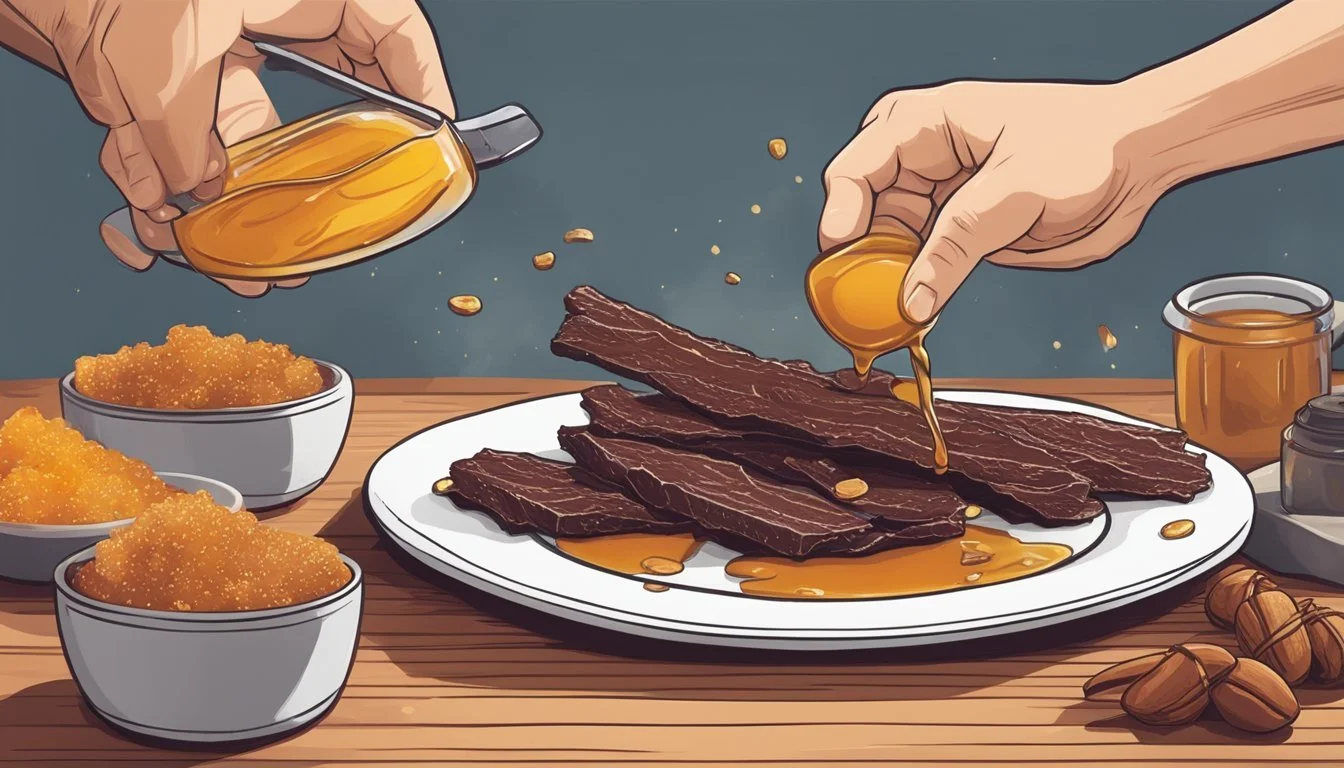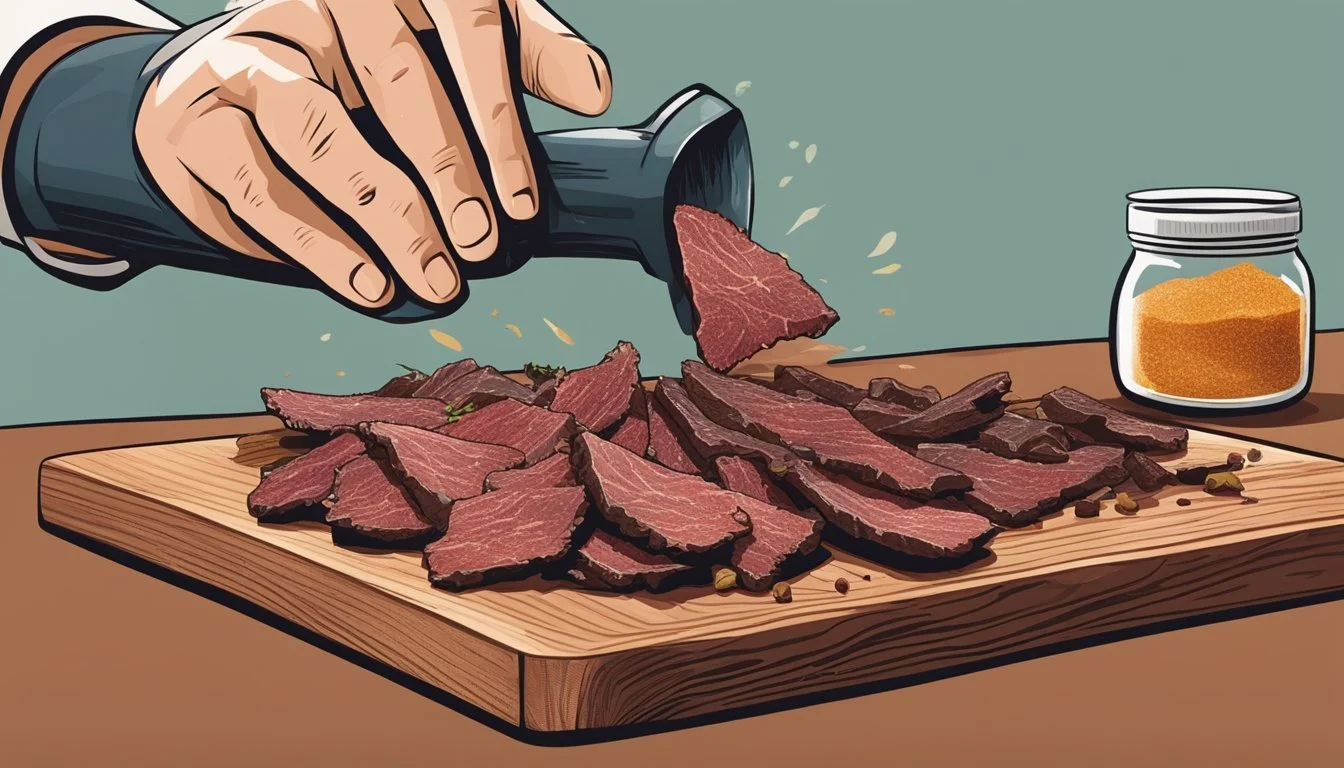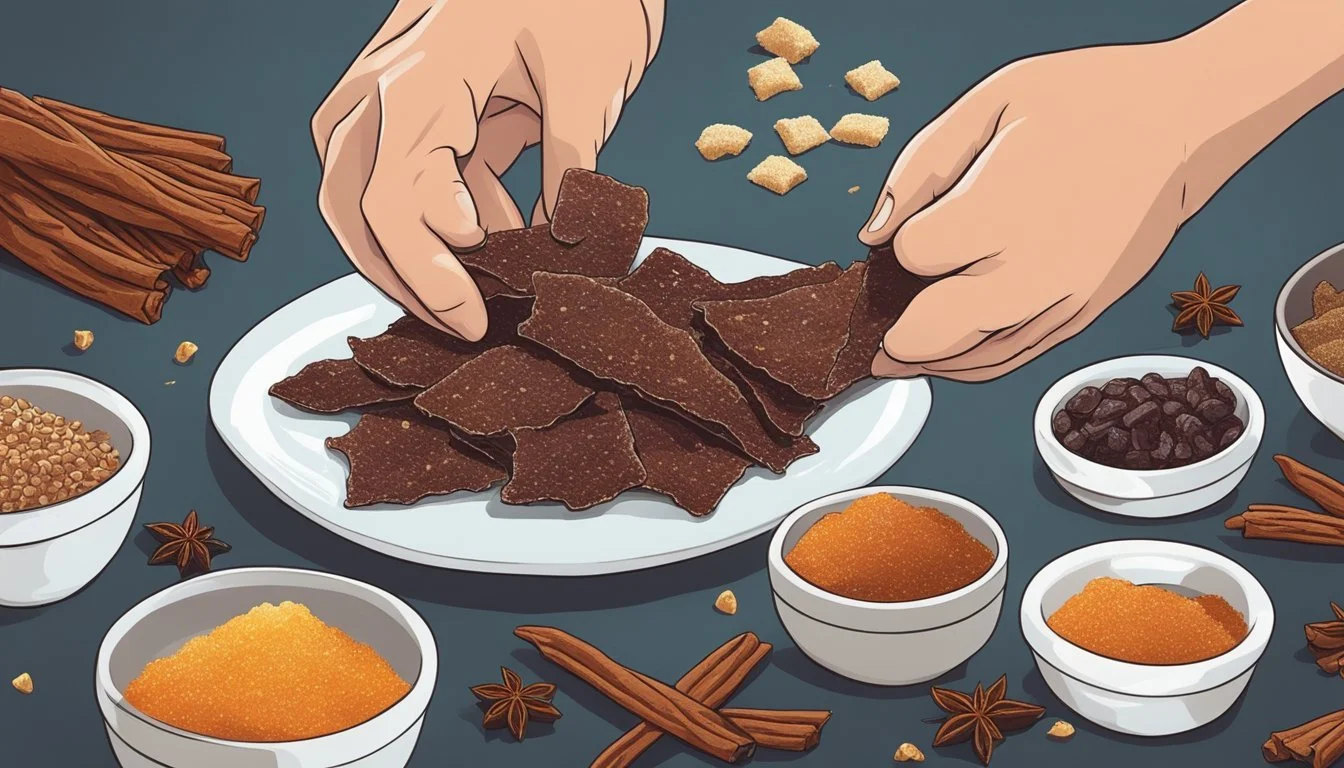Fixing Overly Salty Beef Jerky
Tips for Perfectly Balanced Snack Flavors
Beef jerky is a popular snack favored for its rich flavor, satisfying texture, and long shelf life, making it ideal for on-the-go snacking or as a reliable protein source on outdoor adventures. However, the taste experience can be less than pleasant if the jerky is too salty. The balance of flavors is crucial in beef jerky, as the salt not only preserves the meat but also enhances its savory qualities. When there's an excess, it can overwhelm the palate and overshadow the other nuanced flavors that should be present in the jerky.
Adjusting the saltiness of beef jerky after it's been made can be challenging, but it's not impossible. Methods such as soaking the jerky in water or milk have been recommended to draw out some of the salt. This process, if done correctly, does not significantly compromise the texture of the meat, still providing the chewy bite that jerky enthusiasts appreciate. Ingredients and seasoning play vital roles in achieving the desired taste, making it essential to select and combine them carefully, whether adjusting the jerky post-production or altering the recipe for future batches.
Understanding Beef Jerky Basics
Creating flavorful and perfectly balanced beef jerky involves starting with the right materials and understanding the key processes. From selection of quality meat to the careful addition of spices and the drying process, each step contributes to the final texture and taste.
Selecting Quality Meat
The foundation of great beef jerky is high-quality meat. Typically, cuts like top round, bottom round, or flank steak are preferred due to their lower fat content and ease of slicing. The meat should be fresh and lean, as fat can cause the jerky to spoil more quickly. For the best texture, one should slice the meat against the grain after partially freezing it for easier handling.
Overview of the Drying Process
The drying process is integral to making beef jerky. There are three common methods to dry jerky: using a dehydrator, smoking, or baking in an oven. A dehydrator provides consistent heat and airflow, making it a popular choice. Smoking adds a unique flavor but requires careful temperature control. Oven drying is accessible but can be less precise. The goal is to remove enough moisture to prevent spoilage while maintaining the meat's chewy texture.
Essential Jerky Ingredients
The flavor of beef jerky comes from its ingredients, with the marinade playing a crucial role. Essential ingredients typically include:
Salt: Preserves the meat and enhances flavor. Must be used carefully to avoid overly salty jerky.
Sugar: Balances the saltiness and can contribute to a subtle sweetness.
Spices: Options like black pepper, paprika, and cayenne pepper personalize the jerky's taste profile.
The jerky marinade often combines these components, which then infuses the meat during an 8-12 hour soaking period, contributing to the distinctive savory, sometimes sweet, and often smoky flavors of homemade beef jerky. Careful measurement of spices and salt is key to achieving the perfect balance of flavors.
Identifying Salty Flavors
The process of determining the right amount of salt in beef jerky can be subtle. Salt has several roles, including flavor enhancement and preservation, but excessive amounts can lead to a displeasing salty taste. This section explores how saltiness is introduced, its effect on the jerky's overall flavor, and its importance in preserving the jerky.
Sources of Saltiness in Jerky
The salt in beef jerky can come from various sources, primarily the seasoning and curing process. Seasoning blends often contain table salt or sea salt, along with other herbs and spices. Curing mixes may include sodium nitrate or sodium nitrite, which also contribute to saltiness. It is crucial to measure these ingredients accurately to avoid an overpowering salty flavor.
Common salt sources in jerky seasoning and curing:
Table salt
Sea salt
Sodium nitrate/nitrite
Impact of Salt on Flavor Balance
Saltiness should complement the jerky's flavors, not dominate them. Salt enhances the taste of the jerky by amplifying the savory umami qualities and other inherent flavors of the meat. However, when there's too much, the jerky's complexity diminishes, and the salt begins to mask the subtleties of other spices and seasonings.
Balancing salt's impact:
Enhancement: Small quantities highlight other flavors.
Dominance: Excessive salt overpowers and diminishes complexity.
Salt's Role as a Preservative
In addition to flavor, salt is vital for its preservative qualities in beef jerky. It inhibits the growth of bacteria, ensuring the jerky remains safe to eat over extended periods. The curing process often relies on salt to extend the shelf life of the jerky, making it a crucial component of the snack's preservation.
Preservation qualities of salt:
Inhibition of bacteria: Essential for safety.
Extended shelf life: Allows for longer storage and consumption.
Marination Methods
Proper marination is crucial for achieving the desired balance of flavors in beef jerky, ensuring each bite offers a harmonious blend of tangy, sweet, and smoky notes without overwhelming saltiness.
Creating a Balanced Marinade
To create a balanced beef jerky marinade, it is essential to use the right combination of acidic, sweet, and savory components. Vinegar or Worcestershire sauce can introduce a tangy note, often acting as the acidic base of the marinade that tenderizes the beef while contributing to the overall flavor profile. For sweetness to counteract an overly salty taste, ingredients like brown sugar, honey, or maple syrup can be added; these not only bring balance but also help to create a sticky glaze after dehydration.
A well-crafted marinade for beef jerky also includes an array of spices, such as garlic powder, to enhance the savory aspects. The addition of soy sauce can provide depth and umami, but its saltiness needs to be carefully controlled. It's advisable to taste the marinade before applying it and adjust the sweetness or acidity as needed to hit the perfect flavor note.
Common Marination Mistakes
A common mistake when marinating beef jerky is the overuse of salt or salty ingredients, like soy sauce, which can lead to an excessively salty final product. One should ensure that the sugar content in the marinade is sufficient to mitigate the salt. Another error is failing to evenly coat the beef strips; all pieces should be fully submerged in the marinade to ensure consistent flavor throughout.
Using ingredients out of proportion can also lead to overpowering certain flavors. It’s crucial to measure ingredients such as flavors, spices, and acidic elements carefully to maintain a cohesive flavor profile. Not marinating for an adequate amount of time can result in less flavorful jerky, while marinating for too long can cause the meat to take on too much marinade, making it mushy and altering its texture.
Adjustment Techniques for Overly Salty Jerky
When beef jerky turns out too salty, it's important to know the effective methods to remedy the excess salt. Two main approaches include dilution and the addition of complementary flavors.
Dilution Strategies
Dilution is a straightforward fix to reduce salt concentration in jerky. One can soak the jerky in water or other liquids to draw out some of the salt content.
Soak in Water: Placing overly salty jerky in a bowl of water for 30 minutes to an hour can help alleviate the saltiness.
Water temperature: Cold
Duration: 30-60 minutes
Effectiveness: Varies depending on the salt level
Rinsing: Quickly rinsing jerky under cold water can remove some of the salt from the surface.
Adding Sweeteners and Spices
Balancing the flavor profile with sweeteners and spices can counteract the saltiness of jerky. Sweetness can complement the savory notes, while spices and herbs can add complexity.
Sweeteners:
Brown Sugar: A sprinkle can add a rich sweetness.
Honey: Drizzling honey offers a smooth sweet flavor.
Maple Syrup: Coating jerky lightly provides a distinct sweet taste.
Spices and Herbs:
Incorporating a balanced mix of spices and herbs can introduce new flavor dimensions that overshadow the excess salt.
Flavor Enhancement Alternatives
Enhancing the flavor of overly salty beef jerky involves incorporating elements that counterbalance the saltiness. Acidic components and aromatic herbs are particularly effective in achieving a more balanced taste profile, allowing each flavor to be appreciated without overwhelming saltiness.
Balancing with Acidic Components
A touch of acidity can effectively counteract an excess of salt in beef jerky. A variety of acidic ingredients can be used to add a tangy or citrusy note that complements the smoky and savory flavors of the jerky. Here is a list of acidic ingredients and their applications:
Vinegar: A splash of apple cider vinegar or white vinegar not only reduces the perception of saltiness but also adds a complex, tangy taste.
Citrus Juice: Lemon or lime juice can introduce a fresh, zesty flavor to temper the jerky's salt level.
Balsamic Vinegar: Utilizing balsamic vinegar provides a sweet, yet slightly acidic, enhancement for a more sophisticated taste profile.
Incorporating Aromatic Herbs
Herbs infuse the jerky with aromatic notes that can create a symphony of flavors, taking the focus away from the saltiness. When employing herbs, it's beneficial to use a restrained hand to avoid overpowering the jerky's inherent flavors. Some key herbs include:
Rosemary: Its piney flavor marries well with a smoky jerky, bringing an earthy freshness.
Thyme and Oregano: Herbs like thyme and oregano can deliver a subtle and savory spice that counterbalances excess salt.
Black Pepper and Onion Powder: These spices offer a spicy kick that complements the saltiness and can help round out the overall flavor.
Paprika and Garlic: Paprika brings a smoky essence, while garlic provides a robust taste that can anchor the jerky's flavor profile without adding to its salt content.
By carefully selecting and combining these acidic elements and herbs, one can successfully enhance the flavor of overly salty beef jerky.
Healthy Options and Dietary Considerations
When looking for healthy snack options, it is important to consider both the sodium content and the nutritional value of beef jerky. Choosing options with low sodium and natural flavorings can help maintain a balanced diet, while understanding the nutritional content is key to making informed choices.
Low-Sodium and Natural Flavorings
To ensure beef jerky is part of a health-conscious diet, consumers should seek out low-sodium options. Excessive salt intake can lead to health issues, so opting for jerky seasoned with natural flavors such as garlic powder, onion powder, paprika, cayenne pepper, chili powder, and other spices can enhance taste without the need for additional salt.
Natural flavorings to look for:
Garlic Powder
Onion Powder
Paprika
Cayenne Pepper
Chili Powder
Flavors like these not only contribute to a delicious product but also negate the need for excess salt, making the jerky more suited for a healthy diet.
Nutritional Content in Jerky
Beef jerky can be a nutritious snack, rich in protein, zinc, and other essential minerals. When evaluating the nutritional content of jerky, it's important to look for:
High protein content: Essential for muscle maintenance and repair.
Vitamins: Such as Vitamin B12, which is crucial for red blood cell formation.
Minerals: Including iron and zinc, important for immune function and metabolism.
Nutrient Benefit Protein Supports muscle health and satiety. Vitamin B12 Essential for neurological function. Iron Vital for oxygen transport in the blood. Zinc Crucial for immune function and healing.
In the context of cured meats (What wine goes well with cured meats?) like beef jerky, it is vital that consumers pay attention to these factors to make sure they support their dietary needs without overindulging in sodium.
Cooking Methods and Equipment
When preparing beef jerky, choosing the right cooking equipment and method is crucial to achieving the perfect texture and flavor while ensuring safe consumption. A dehydrator, oven, or smoker can effectively remove moisture from the meat, which is important in the jerky-making process.
Using a Dehydrator Effectively
A dehydrator is specialized equipment designed for drying foods by circulating warm air with a temperature control feature usually ranging from 95°F to 160°F (35°C to 71°C). When using a dehydrator, one should ensure even placement of meat slices on the trays to promote uniform drying. The optimal temperature for drying beef jerky is typically between 135°F to 145°F (57°C to 63°C), and the process can take anywhere from 4 to 15 hours depending on the thickness of the slices and the desired level of dryness.
Oven-Drying Technique
Alternatively, one can use an oven to dry beef jerky if a dehydrator is not available. The key is to maintain a low temperature -- about 170°F (77°C) is usually the lowest setting on most ovens. To facilitate drying, the oven door should be kept slightly ajar to allow moisture to escape. Placing the beef on a wire rack over a baking sheet helps air circulation around the meat, promoting an even drying process. The duration of oven-drying can vary but generally takes about 4 to 8 hours.
Pros and Cons of Smoking
Using a smoker infuses a distinctive smoky flavor into the jerky that cannot be replicated by other drying methods. To smoke beef jerky, one would season the meat strips and smoke them at a low temperature, around 160-180°F (71-82°C), for several hours. While smoking adds a unique taste and aroma, it is a more involved process that requires careful temperature monitoring and can take longer than dehydrating or oven-drying.
Each of these methods involves the critical control of heat and temperature, underscoring their importance in food preservation and flavor development in beef jerky.
Finalizing and Storing Homemade Jerky
The final steps of creating homemade beef jerky are critical for ensuring the right balance of flavor and texture. Proper drying and storage are paramount to maintaining freshness and preventing spoilage.
Ensuring Proper Dryness
Once the beef jerky has been seasoned and potentially soaked to mitigate excessive saltiness, it should be thoroughly dehydrated. The drying process is essential for creating a texture that is pleasantly chewy rather than tough or brittle. Homemade beef jerky typically requires a dehydrator or a low-temperature oven setting to remove moisture content effectively.
Dehydrator: Set the dehydrator according to the manufacturer's instructions, usually between 135°F and 160°F. The jerky is done when it bends and cracks but does not break completely.
Oven-drying: For those using an oven, it's advised to preheat to the lowest setting, often around 175°F, and keep the door slightly open to allow moisture to escape. The jerky can take around 3 to 4 hours to dry, but times can vary significantly based on oven performance and slice thickness.
Storage Tips for Freshness
Proper storage is the key to extending the shelf life of homemade beef jerky and preserving its freshness. Since homemade jerky lacks commercial preservatives, it's susceptible to spoilage if not stored correctly.
Cool and Dry: Store jerky in a cool, dry environment. Humidity and high temperatures can lead to mold growth and spoilage.
Airtight Containers: Vacuum-sealed bags, airtight jars, or double-bagged resealable bags are excellent choices for storage.
Refrigeration: For longer-term storage, place jerky in the refrigerator at or below 40°F.
Freezing: For the longest shelf life, freeze beef jerky at 0°F. Use a freezer-safe container to prevent freezer burn.
By bagging the jerky properly and selecting an appropriate storage method, one ensures that the hard work put into curing and preparing the jerky results in a product that stays fresh and enjoyable for an extended period.
Creative Uses for Overly Salty Jerky
When overly salty jerky isn’t ideal for direct snacking, it can find a new life in various dishes, where its intense flavor enhances other ingredients. The key is to incorporate it in a way that balances its saltiness with other flavors, or uses it as an accent to elevate a recipe.
Integrating Jerky into Recipes
Soups and stews: Overly salty jerky can be diced and added to soups and stews. As the jerky simmers, its salty coating infuses the liquid, distributing the flavor and reducing the need for additional salt. Here, the salty jerky acts not only as a protein addition but also as a seasoning agent, giving depth to a dish that may otherwise require more ingredients. This is particularly useful for achieving a milder flavor overall, as the salty jerky's presence allows other flavors to come forward without overwhelming.
Grain and vegetable dishes: One can shred salty jerky and sprinkle it over rice or vegetable dishes. This not only adds a unique flavor but also a pleasant textural contrast. In doing so, jerky can be a valuable topping, offering a savory boost to otherwise bland dishes. When utilizing it in this fashion, it's best paired with ingredients that have a sweet or neutral taste profile to counterbalance the jerky's saltiness.
Culinary Experiments with Salty Snacks
Sweet and salty combinations: Jerky's salty bite can be a key component in sweet and salty snack mixes. By cutting the jerky into small pieces and combining it with items like chocolate, dried fruit, or caramel popcorn, one can create a trail mix that delights the palate with every bite. The contrast between sweet components and the jerky's saltiness creates a balanced, multi-dimensional taste experience.
Homemade seasoning: One can blend finely ground salty jerky with other spices to create a unique flavor enhancer. This homemade seasoning can be used to sprinkle on dishes just before serving, adding an instant burst of flavor. This creative use not only repurposes jerky but also sparks creativity in the kitchen, encouraging a personal touch to familiar recipes.
Conclusion
Beef jerky is a satisfying and chewy option for on-the-go snacking, especially during outdoor activities. However, an overly salty taste can detract from the enjoyment of this protein-rich snack.
Strategies to Mitigate Saltiness
Soaking in Water: Submerging jerky in water for 15–30 minutes can remove excess salt.
Adjusting Recipes: Decrease salt incrementally in future batches to find a balance.
Rinsing: A brief cold water rinse may also rid the jerky of some surface salt.
Consumers concerned with overly salty jerky can apply these fixes to enhance their snacking experience. When preparing homemade jerky, one should always opt for a cautious approach to salt, adding it gradually and taste-testing to ensure flavors remain well balanced.
They are also encouraged to consider personal preferences and dietary needs when adjusting the salt content. With these adjustments, beef jerky can remain a staple snack that is both delicious and suitable for a variety of occasions, without the worry of overconsumption of salt.


